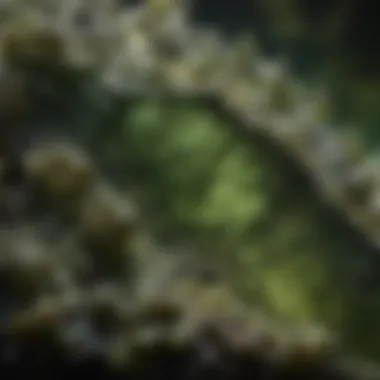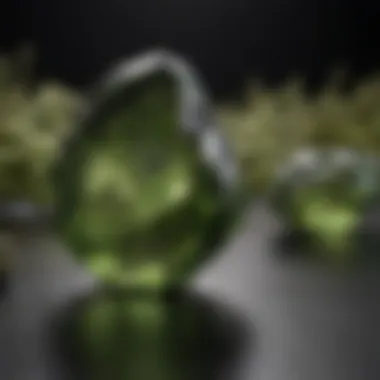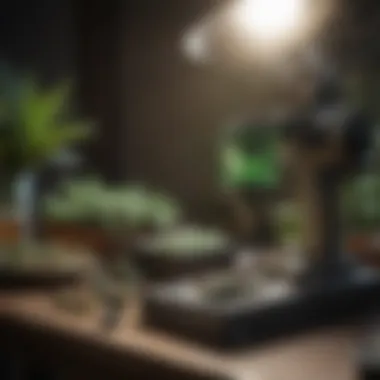Real Moldavite vs Fake Moldavite: Identifying Authenticity


Intro
The presence of moldavite in the gemstone market has captured the attention of collectors, jewelry designers, and enthusiasts alike. This unique green gemstone, known for its extraterrestrial origin, poses a challenge when it comes to evaluation and authenticity. In recent years, the rise of counterfeit moldavite has made it essential for interested parties to equip themselves with critical knowledge about distinguishing real specimens from fakes. This guide aims to unpack the intricacies of moldavite, focusing on its characteristics, historical significance, and practical methods for verification.
Gemstone Overview
Definition and Characteristics
Moldavite is a type of tektite, formed from a meteorite impact approximately 15 million years ago in what is now the Czech Republic. It possesses a distinctive olive green to dark green coloration, often with a translucent quality that can enhance its appeal. Authentic moldavite typically exhibits a smooth surface, although it may display natural surface textures and inclusions that add to its character.
Key characteristics of real moldavite include:
- Color: Typically green but can vary in hue depending on specific conditions during its formation.
- Weight: Real moldavite tends to be lightweight compared to many other gemstones due to its glassy nature.
- Surface: Authentic samples may reveal a semi-glassy texture with additional patterns due to natural formation processes.
Classification of Gemstones
Understanding how moldavite fits into the classification of gemstones is crucial for enthusiasts. Gemstones are often categorized into precious and semi-precious stones. Moldavite, while not particularly rare and considered semi-precious, possesses an allure due to its unique origin and aesthetic appeal.
Types of gemstones include:
- Igneous: Formed through volcanic activity; not applicable to moldavite.
- Metamorphic: Resulting from heat and pressure; moldavite does not belong here.
- Sedimentary: Formed from sediment; moldavite originates from meteoric impacts.
Historical Significance
Ancient Uses and Cultural Importance
The historical backdrop of moldavite is intertwined with various cultures and their beliefs. In ancient times, moldavite was often regarded as a talisman or protective stone. Its connection to the cosmos made it popular among those seeking metaphysical benefits. It has been believed to enhance intuition and promote transformation.
Myths and Legends Surrounding Gemstones
Throughout history, gemstones have inspired countless myths and legends. Moldavite is no exception. Some believed it was associated with celestial beings and held powers beyond the terrestrial realm. Whether as ornaments or used in rituals, its perceived energy has made moldavite a revered object of fascination.
"Moldavite is often considered a ‘stone of transformation,’ embodying the essence of change and evolution in both physical and spiritual domains."
By understanding the broad context of moldavite, collectors and enthusiasts can appreciate its value beyond mere aesthetics. The gemstone's story enriches its potential significance in one’s collection or jewelry designs.
Equipped with this foundational knowledge, readers will now be better prepared to evaluate moldavite, distinguishing genuine pieces from counterfeit imitations in the market.
Prologue to Moldavite
Moldavite has garnered attention in recent years as a unique and captivating gemstone, boasting not only aesthetic beauty but also a wealth of geological and historical significance. Understanding what moldavite is, its formation, and its distinct characteristics is crucial for anyone interested in this gem. As moldavite enthusiasts and collectors become more discerning, the need to differentiate between authentic specimens and counterfeit replicas has intensified. This article aims to guide you through the intricacies of moldavite, ensuring you can make informed choices in your exploration of this fascinating stone.
What is Moldavite?
Moldavite is a natural glass formed from a meteoric impact that occurred approximately 15 million years ago in what is now the Czech Republic. Its color ranges from translucent green to dark olive and even browns. The stone is distinct in its texture, often exhibiting bubbles, swirls, and unique surface patterns. Many believe it has mystical properties, appealing to spiritual practitioners around the world. Its allure is not just from its spiritual claims but also from its rarity and scientific significance.
The Geological Formation of Moldavite


The geological formation of moldavite is a striking example of nature's unpredictable processes. When a meteorite impacted the Earth's surface, the intense heat and pressure caused surrounding material to melt and vaporize. As the molten material cooled rapidly, it formed the glassy substance we recognize as moldavite today. This event created the conditions necessary for the unique moldavite we see.
- Location: Most of the moldavite found on earth originates from the southern part of the Czech Republic, particularly in the regions of Moldau River basin. This is where the impact occurred.
- Composition: Moldavite consists primarily of silica, containing small amounts of other minerals, which contribute to its color and texture.
The historical context surrounding moldavite adds another layer of intrigue. It has been used in jewelry and decorative arts for hundreds of years, cherished for its beauty and purported energetic properties. Understanding its formation helps appreciate the stone’s uniqueness, which in turn is essential for discerning its authenticity. The exploration of these topics lays a solid foundation for understanding both real and fake moldavite, crucial for anyone involved in the gemstone market.
Understanding Authentic Moldavite
Understanding authentic Moldavite is crucial for anyone involved in the realms of gemstones, jewelery design, or collection. Moldavite possesses unique characteristics that differentiate it from other stones. By focusing on these attributes, enthusiasts can avoid the pitfalls of purchasing counterfeit pieces. This understanding fosters confidence in both buyers and sellers, ensuring that transactions are rooted in knowledge and authenticity. Moreover, being informed about genuine Moldavite demonstrates respect for the stone’s historical and geological significance. It highlights the value of learning how to recognize authenticity, thereby appreciating the investment more fully.
Physical Characteristics of Genuine Moldavite
Genuine Moldavite has distinct physical characteristics that set it apart from imitations. It has a unique greenish hue, ranging from olive-green to dark green. Real Moldavite often exhibits a waxy or glassy finish. This texture arises from its formation through a meteorite impact millions of years ago. Authentic specimens are typically lightweight for their size yet possess an unusual density. This characteristic might surprise some, as Moldavite feels heavier than one might assume based on appearance.
In addition to color and texture, the surface of genuine Moldavite often presents irregularities. Natural pieces showcase inclusions and bubbles. These attributes are not defects but signs of authenticity and geological history. Recognizing these traits helps collectors and buyers affirm the stone’s genuineness.
The Importance of Clarity and Color
Clarity and color play a significant role in determining the value of Moldavite. Authentic Moldavite enhances its allure through these features. In clarity, the most sought-after pieces avoid cloudiness. Instead, they maintain a transparency that reveals their vibrant color and internal structure.
Color serves both aesthetic and market value purposes. Deep greens signify higher quality, while lighter shades could indicate lower value. Typically, fragments with vivid color display strength in their origin. Reflecting on these aspects helps prospective buyers establish a better understanding of what to seek or expect in their purchases. Even small shifts in color tones can greatly affect the overall desirability of a specimen.
Understanding the nuances in clarity and color helps differentiate between genuine Moldavite and its counterfeit variants. Being knowledgeable about these elements deepens appreciation for the stone and enhances one’s ability to make informed purchases.
Identifying Fake Moldavite
The topic of identifying fake moldavite holds considerable significance for both collectors and enthusiasts. Moldavite's unique characteristics make it desirable, yet this has also led to a proliferation of counterfeit products in the market. Ensuring authenticity protects buyers from misinvestment and supports the integrity of the gemstone market. Recognizing how to spot fake moldavite can save individuals from potential financial loss and disappointment.
Understanding the common techniques used in counterfeit production provides insight into how these imitation stones are made. This information is crucial not only for gem collectors but also for jewelers and dealers who regularly interact with moldavite.
Moreover, familiarity with visual distinctions between genuine and fake moldavite aids in quick recognition. This knowledge empowers buyers to make informed purchasing decisions through educated assessments. Hence, learning about identifying fake moldavite is paramount for anyone dealing with this enchanting gemstone.
Common Techniques Used in Counterfeit Production
Counterfeiters employ various methods to reproduce the appearance of authentic moldavite. Here are some common techniques:
- Glass Production: Many counterfeit moldavites are simply glass replicas. These glass pieces can be shaped and colored to mimic the look of natural moldavite.
- Synthetic Materials: Some fakes utilize synthetic gemstones that closely resemble the color and clarity of genuine moldavite. These materials may be created in labs, aiming to deceive unwary buyers.
- Mold Techniques: Others create molds of actual moldavite pieces. They pour synthetic resin or similar substances into these molds, producing a nearly identical shape but lacking authentic glass characteristics.
- Altered Natural Stones: Some counterfeit pieces may involve actual stones that have undergone extensive alteration. Through treatments that enhance color or clarity, these stones can be made to appear like moldavite.
These techniques often lead to visual similarities between real and fake stones, making identification challenging for untrained eyes.
Visual Differences Between Real and Fake Moldavite
The visual inspection of moldavite can yield several telltale signs that distinguish genuine stones from their counterfeit counterparts. Here are key aspects to examine:
- Color Consistency: Real moldavite typically exhibits variations in color. Counterfeit stones may have a uniform color across the surface, which is a clear sign of inauthenticity.
- Bubbles and Inclusions: Authentic moldavite often contains small gas bubbles and inclusions. If a piece appears too clear or has an unnatural uniformity, it is likely a counterfeit.
- Surface Texture: Genuine moldavite exhibits striations and surface textures resulted from its formation in high-heat conditions. In contrast, fake stones often have a smoother finish.
- Weight: Authentic moldavite is lighter than glass of similar size. Weighing the piece can help to identify fakes, which often feel heavier than expected.
"Understanding these differences is key in ensuring that collectors and enthusiasts obtain authentic moldavite for their collections."
Market Trends and Moldavite Pricing


The market for moldavite has experienced notable fluctuations in recent years. Understanding these trends offers invaluable insights for enthusiasts and collectors. Awareness of pricing dynamics assists individuals in making informed decisions when buying or selling moldavite. Beyond simply understanding value, knowing market trends helps establish a framework for evaluating authenticity. As the demand grows, so does the complexity of differentiating between real and counterfeit pieces.
Current Market Value of Authentic Moldavite
Authentic moldavite, due to its rarity and unique characteristics, commands a premium price in the gemstone market. Prices can vary significantly based on factors like clarity, color, and size. As of recent data, high-quality pieces range from 50 to 1000 USD per gram, with exceptionally clear specimens possibly exceeding this range.
Factors influencing the value include:
- Source: Moldavite only originates from the Czech Republic, which limits its availability.
- Clarity: The more transparent the stone, the more valuable it typically is.
- Size: Larger pieces often have a better per-gram price than smaller fragments.
It is crucial to keep an eye on recent sales and price listings from reputable dealers to gauge market value accurately. To stay updated, consider checking resources like Wikipedia or jewelry auction sites.
Price Indicators for Counterfeit Moldavite
Identifying counterfeit moldavite requires vigilance and understanding of market prices. Fake moldavite often shows a significantly lower price point, which can be a red flag. Counterfeit prices usually fall below the 25 USD per gram threshold. Here are additional indicators to watch for:
- Unusually Low Prices: If an offer seems too good to be true, it likely is. Always compare with reputable sources.
- Seller Reputation: Be cautious of sellers without a history or positive feedback.
- Inconsistent Quality: Fake pieces may lack the consistent physical properties seen in authentic moldavite.
Recognizing these signs can help protect buyers from financial loss. Evaluating price with an understanding of authenticity also enhances confidence in one's collection.
The increased popularity of moldavite has led to a surge in counterfeit products, making knowledge of market trends essential for collectors.
Methods for Testing Moldavite Authenticity
Testing the authenticity of moldavite is a critical aspect for collectors, jewelry designers, and gemstone enthusiasts. The methods employed in these tests can significantly impact how individuals perceive the quality and value of their stones. Understanding these methods provides insight into ensuring that one's investment is well-placed and that the gem one possesses is indeed genuine.
Basic Testing Techniques at Home
For those who want to determine whether their moldavite is real without extensive tools, several basic techniques can be conducted at home. These methods are straightforward and can yield useful initial insights:
- Visual Inspection: Real moldavite often exhibits natural features, such as inclusions and bubbles, which counterfeits may lack. Holding the stone under direct light can reveal such characteristics.
- Weight Test: Genuine moldavite is relatively lightweight due to its unique composition. If a stone feels unusually heavy compared to its size, it might be a fake.
- Heat Test: When heated, real moldavite will react by changing its structure slightly, while many fakes will not show this kind of adjustment. This method requires careful execution to avoid damaging the stone.
- Water Test: Authentic moldavite, due to its density, tends to sink in water while some fakes may float. This is a simple way to check for authenticity, though it is not definitive.
While these tests provide good initial information, they do not replace the thorough assessments that a professional can offer.
Professional Evaluation and Certification
For gemstone lovers and serious collectors, seeking professional evaluation is vital. Experts in the field have specialized knowledge and equipment that allow for a more detailed analysis of moldavite.
- Gemology Laboratory Assessment: Reputable gemology labs use advanced technologies to assess the structure and properties of moldavite. Instruments such as refractometers and spectrometers help in determining the gem’s authenticity.
- Certification Services: Authentic moldavite should ideally come with a certification from a recognized body. Certificates detail the stone's characteristics, ensuring buyers of its legitimacy.
- Weight and Measurement Analysis: Professionals will assess the specific weight and dimensions against known standards for moldavite, which is crucial for authentication.
- Documentation: Any purchase of high-value moldavite should include detailed documentation that confirms its origin, authenticity, and characteristics.
"Obtaining a professional evaluation can safeguard your investment and ensure that your collection includes only genuine moldavite."
Storage and Care for Moldavite
Proper storage and care of moldavite is crucial for maintaining its beauty and integrity over time. Moldavite, being a sensitive gemstone formed from a unique geological event, requires specific attention to ensure it does not suffer damage from environmental factors or mishandling. The way moldavite is stored can directly influence its physical condition, value, and overall appearance. Gemstone enthusiasts, collectors, and jewellers must understand these nuances.
Best Practices for Storing Moldavite


The storage environment for moldavite is essential in preserving its quality. Here are the best practices to consider:
- Use a Soft Container: Place moldavite in a soft velvet or silk pouch. This prevents scratches that can occur from contact with harder materials.
- Temperature Control: Store moldavite in a cool, dry place. Avoid exposure to extreme heat or humidity which can affect the structure of the stone.
- Separate Storage: Keep moldavite away from other gemstones and jewelry. Each item should have its own designated space to prevent scratches and other damage.
- Avoid Direct Sunlight: Long exposure to sunlight may cause fading in color or alterations in appearance.
- Frequent Inspection: Regularly check the stone for any signs of damage or wear. This allows for early detection of problems before they worsen.
Maintenance Tips to Preserve Authenticity
Caring for moldavite goes beyond storage. Regular maintenance ensures that its authenticity and value are preserved:
- Gentle Cleaning: Clean moldavite gently using a soft, damp cloth. Harsh chemicals can degrade its surface, so avoid any cleaning agents.
- Minimize Handling: Limit direct handling of the stone. Oils and dirt from the hands can accumulate on the surface, affecting clarity and shine.
- Professional Assessment: If there are concerns about the authenticity or condition of moldavite, consult a professional gemologist for evaluation.
- Avoid Jewelry Stress: When set in jewelry, ensure the setting does not exert unnecessary pressure on the stone, which could cause fractures or chips.
"Proper care of moldavite is essential to preserve its distinctive qualities and investment value. Regular inspection and gentle handling can extend its lifespan significantly."
Through deliberate storage and regular maintenance, enthusiasts can enjoy their moldavite while retaining its unique characteristics and value.
Historical Significance of Moldavite
Moldavite holds an esteemed position in both geological and cultural realms due to its unique origin and historical background. This gemstone is not only a subject of fascination for collectors but also an important artifact in understanding human history and ancient beliefs. The significance of moldavite extends beyond its physical properties; it encompasses the narratives woven around it throughout time. This section will shed light on its cultural importance in ancient civilizations and its modern uses and symbolism.
Cultural Importance in Ancient Civilizations
Moldavite’s significance dates back thousands of years, particularly in Central Europe where it was found. Archaeological evidence suggests that ancient people revered moldavite, using it in various rituals and as a material for crafting ornaments. The Bohemian region of modern-day Czech Republic, where most of the world’s moldavite is sourced, saw moldavite utilized by the Celts. The Celts often associated it with protection and transformation. They believed that moldavite could connect them to spiritual energies, serving as a conduit for cosmic forces.
Artifacts discovered in burial sites indicate that moldavite was valuable not only for its origin but for its aesthetic properties as well. The gem’s vibrant green color and intriguing textures made it appealing for use in jewelry and ceremonial objects. Its rarity and beauty led many to attribute magical properties to the stone, insisting it could bring prosperity and increase spiritual awareness. Today, modern gem enthusiasts often appreciate moldavite not just for its beauty, but also for this rich historical tapestry that adds depth to its allure.
Modern Uses and Symbolism
In contemporary society, the symbolism of moldavite has evolved while still honoring its ancient roots. Today, many people view moldavite as a powerful tool for meditation and personal growth. It is often thought to vibrate at a high frequency, promoting transformation and emotional healing. As a result, moldavite finds its place in the wellness industry, often used in alternative healing and new-age practices.
Moreover, moldavite is popular among jewelry designers, whose creations highlight the stone’s uniqueness and its connection to history. It has become a sought-after item for modern jewelers looking to infuse their designs with a blend of natural beauty and metaphysical significance. The pieces often serve as conversation starters about not only the stone itself but also its extensive history and symbolism.
"Moldavite is more than just a gemstone. It embodies a rich history that connects us to ancient civilizations, making it a potent symbol of emotional and spiritual transformation today."
In essence, moldavite serves as a bridge between the past and the present, encapsulating the aspirations and beliefs of those who came before us. Its historical significance and modern applications offer valuable insights for gem enthusiasts and collectors alike, proving that this gemstone is not merely a trinket but a key to understanding our collective heritage.
Finale
In the realm of gemstones, understanding authenticity is crucial, especially when it comes to precious stones like moldavite. This article dissected various aspects of real and fake moldavite, providing essential insights that potential buyers and collectors should consider. Knowing how to identify genuine moldavite ensures that investments are sound and that the charm of this unique gem is preserved.
Summarizing Key Differences
Key differences between real and fake moldavite lie in physical characteristics, clarity, and price indicators. Authentic moldavite exhibits a distinctive texture, often containing inclusions and other forms typical of its natural formation. Fake moldavite, however, often lacks these features, appearing overly uniform or too perfect.
- Color: Real moldavite displays a range of colors including deep green and transparent shades, whereas fake versions may have unnatural hues.
- Weight: Genuine moldavite is relatively lightweight compared to glass imitations.
- Bubble Presence: Counterfeit stones commonly show air bubbles or defects that are absent in authentic specimens.
Recognizing these differences equips buyers to make informed choices, safeguarding against the risk of purchasing counterfeits.
Final Thoughts on Moldavite Authenticity
Maintaining an awareness of moldavite's authenticity is not merely about economics. It relates to an appreciation of the gem's historical and geological significance. As moldavite continues to gain popularity, the market has seen an influx of imitations.
Buyers should prioritize the following:
- Research: Investigate into the seller’s reputation and the stone’s origins.
- Testing: Use both home techniques and seek professional evaluations when in doubt.
- Education: Understand the characteristics of genuine moldavite to build confidence in one’s purchasing decisions.
In a competitive and sometimes deceptive market, knowledge is the best defense. By implementing the purchasing strategies discussed, collectors and enthusiasts can not only enhance their collections but also honor the legacy of this extraordinary gemstone.







